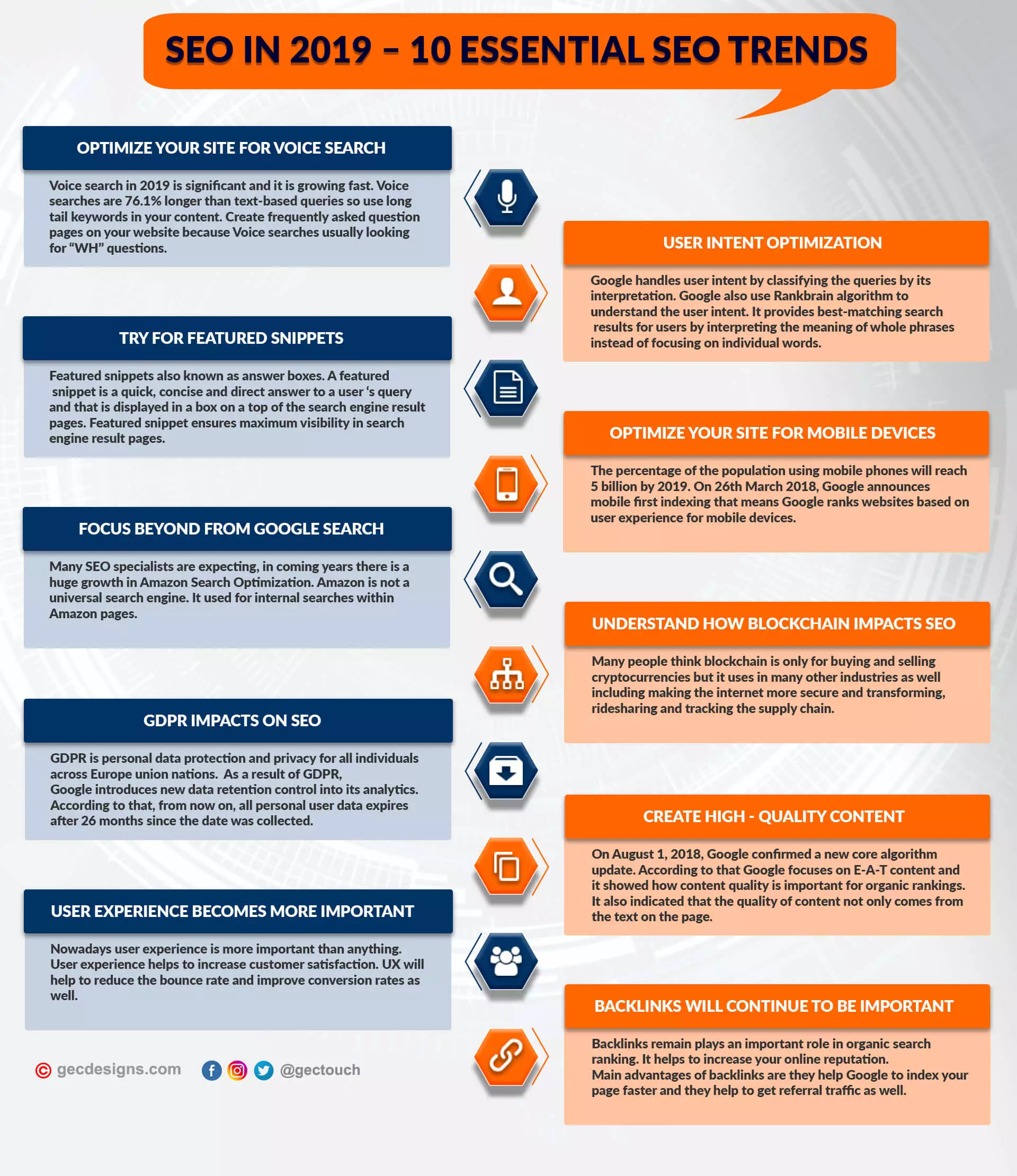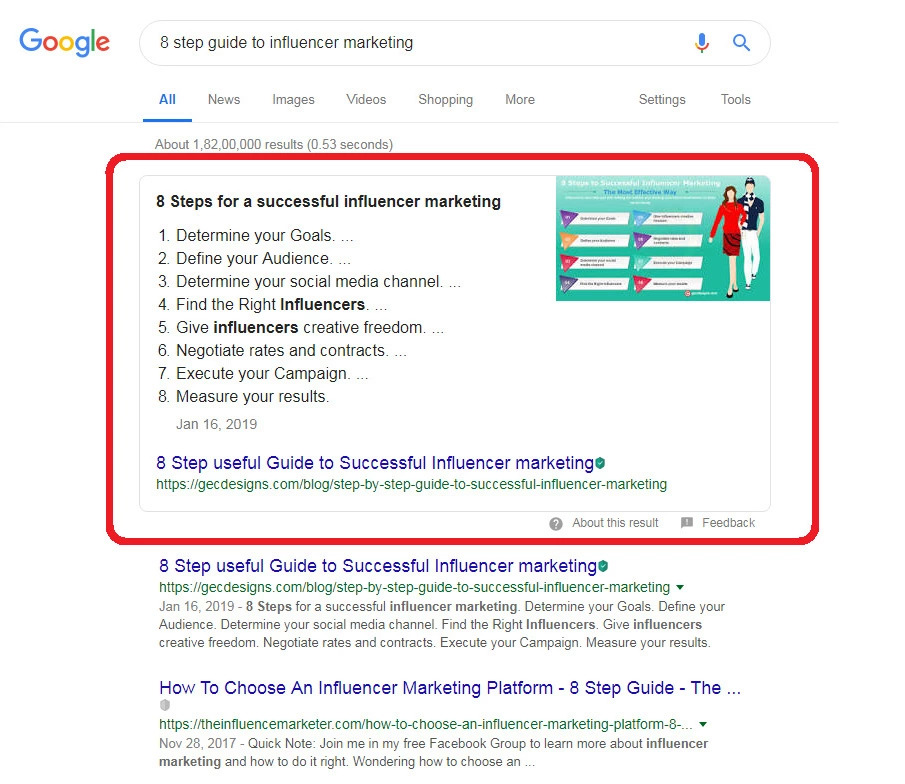Top 10 Essential SEO trends to follow in 2019
SEO is always evolving, and the trends keep changing every year. In today’s competitive environment, search engine optimization is really important for every business to increase its visibility through search engine rankings. To stay ahead of the competition you must update yourself with the latest SEO trends and strategies.
What are the new SEO trends in 2019?
Here we have listed the top 10 essential SEO trends you need to follow in 2019. I hope these tactics will help you to increase your business website visibility in search engine result pages and boost your rankings.
- Optimize your site for voice search
- User intent optimization
- Try for featured snippets
- Optimize your site for mobile devices
- Focus beyond from Google search
- Understand how blockchain impacts SEO
- GDPR impacts on SEO
- Create high-quality content
- User experience becomes more important
- Backlinks will continue to be important
1. Optimize your site for voice search
Voice search in 2019 is significant for online businesses to focus on, the percentage of voice search growing rapidly since the introduction of smart devices. People are using voice assistants, and smartphones to search for information. Voice search is an easy, and quick way to search for information on the internet, so it is essential for webmasters to optimize their content with voice friendly search.
According to Gartner, by 2020, 30% of web browsing sessions will be done without a screen.
According to a recent study by the year 2020, 50% of all online searches will be conducted by voice. Apple, Amazon, and Google already developed their personal assistants known as Siri, Alexa, and Google assistant.
Voice search queries are different
When users are typing on a device to find information, they tend to use short phrases with specific keywords. For example, if you are looking for SEO trends, you may type SEO trends 2019.
On the other hand, when users use voice search, they behave like they are talking to a human. Voice search queries are more conversational in nature, and those search queries would be longer. You will probably ask, what are the latest SEO trends in 2019.
Voice searches are 76.1% longer than text-based queries so use long-tail keywords in your content helps to increase the chances of your ranking in voice searches. Long-tail keywords have better click-through rates and it also cheaper than short keywords.
According to bright local, 58% of consumers used voice search to find information on a local business within the last year. So you need to optimize your website for local search because the users use words like “near me” in voice search.
Create frequently asked question pages on your website because Voice searches usually looking for “WH” questions.
2. User intent optimization
User intent is the identification of what a user wanted when they typed their search query into a search engine. User intent is also known as query intent.
Every day Google processes billions of searches, and behind every search, there is an intention. Google handles user intent by classifying the queries by its interpretation.
Google also uses the Rankbrain algorithm to understand user intent. RankBrain is a machine-learning algorithm that uses artificial intelligence that helps Google better understand the meaning behind user queries. It provides best-matching search results for users by interpreting the meaning of whole phrases instead of focusing on individual words. It also provides contextual results based on previous searches or even the user’s location.
There are three basic types of user intent,
- Navigational - the User is seeking a specific website or webpage.
- Informational - User looking for general information
- Transactional - The user is preferred to make a purchase
Use LSI keywords in your content that helps to strengthen the context of your article. So search engines can easily pick up your content for related searches. Latent semantic indexing keywords are related keywords to the main keyword.
You can use LSI keywords anywhere within your content including title tag, description tag, anchor text, first and last paragraph of your article.
Keep your user’s intent in mind while creating content. Answer all possible questions that the user may use when searching for information.
3. Try for featured snippets
Featured snippets are called answer boxes. A featured snippet is a quick, concise, and direct answer to a user‘s query, also it is displayed in a box on the top of the search engine result pages. The featured snippet is often referred to as a ‘Position zero” because it appears above the first organic search result.
This answer is directly pulled from a webpage and that also contains a link to that page, a URL, and a page title.
There are four types of snippets,
- Paragraph featured snippets
- The list featured snippets (bulleted and numbered)
- Table featured snippets
- Video featured snippets
Here is an example for the featured snippet,
Benefits of featured snippets
- Featured snippet ensures maximum visibility in search engine result pages.
- It steals organic traffic from all the other search results.
- Featured snippets provide quick answers, so the user loves featured snippets. Also, It helps to increase traffic to your website.
According to Ahrefs, Google shows featured snippets for 12.3% of search queries and 8.6% of all clicks go to the Featured Snippet in those search results.
Tips to optimize content for featured snippets
Find out the questions that your target audience are looking for – Many people use questions as their search queries to find information. Your first step is finding out the questions to target. Create content that starts with,
- What is
- How is
- Why is
- Who is
- How to
- Comparisons (X vs Y)
Make sure that your answer is within 40 to 50 words because Google displays a short section of text only.
Create content that specifically answers the questions – Content should ensure to answer questions concisely and clearly. Include the questions or search terms or keywords you are targeting in subheadings which users search for on Google and place the answers immediately after that with a tag.
Organize your content in lists – structure your content in a list format that will help to increase your chances of displaying as a list feature snippet. Organize your lists or steps with headers.
Use a table structure – organize your content in a table format can help you to rank for featured snippets.
Provide high quality, in-depth content – find related questions you can answer with the help of Google’s autocomplete and searches related to feature.
Add high-quality images and videos – Most featured snippets often include an image in the answer box. Use eye-catching images on your content increases the chances of your content getting displayed on the featured snippets.
For your business's success, you must increase your visibility in search engines. The right use of SEO techniques and staying up to date on trends will help to achieve your goals.
4. Optimize your site for mobile devices
Nowadays most of us are accessing content via mobile phones instead of the desktop. The percentage of the population using mobile phones will reach 5 billion by 2019.
On 26th March 2018, Google announces mobile-first indexing that means Google ranks websites based on user experience for mobile devices.
In 2019, responsive web design or mobile-first indexing becoming a significant factor for ranking. According to Statista, in 2018, 52.2% of all website traffic was generated through mobile phones.
You can use Google’s mobile-friendly test to know whether your website is mobile-friendly or not. If your website is not mobile-friendly that will affect your ranking so now it is the time to optimize your site for mobile-friendly.
Here are a few things that will help you to prepare for the mobile-first index.
Choose a responsive web design - Responsive web design is a website load properly on all devices, like desktop, tablet, laptop, and smartphone. The design adapts to fit perfectly on the screen without zooming and scrolling. Use a fluid grid and flexible texts and images to automatically adapt to the size of a user’s screen.
Optimize website speed – page speed is more critical for mobile users than desktop users. Your website needs to be load quickly for a better user experience.
According to Google’s mobile page speed study, if your site’s loading time increases from 1 second to 10 seconds the bounce rate will increase by 123%.
Use a fast web host, use a CDN, optimize images, minify codes are a few ways to improve your website speed.
In our previous blog post, we have listed 13 effective ways to optimize website speed.
Don’t block CSS, Javascript, or images - In the old days of mobile design, blocking these elements was helpful, because some mobile devices couldn’t support those elements. Now smartphones are more powerful than computers. The Smartphone GoogleBot can handle all of these elements. So make sure that you don't hide them, it will help Google to categorize and rank your content.
Remove pop-ups from the mobile site – It can interrupt the user’s browsing experience, and it is difficult to close on mobile devices. Pop-ups will lead to a high bouncing rate, and you need to avoid using for mobile screens.
Don’t use Flash – flash is bad for SEO because it can seriously slow down your page’s load time. It will affect your user’s experience. HTML5 supports interactive elements so you can avoid using flash in your websites.
5. Focus beyond from Google search
Many SEO specialists are expecting, in coming years there is a huge growth in Amazon Search Optimization. Amazon is not a universal search engine. It used for internal searches within Amazon pages. When searching for products, most of the shoppers go directly to the Amazon search bar rather than Google.
According to Kenshoo, 56% of consumers visit Amazon first if they are planning to shop. 51% check for a product with Amazon after finding something elsewhere.
If you like to buy a product, Amazon offers you to see comparisons, product reviews, and it also similar product suggestions that mean you don’t need other search engines to find what you need.
If you have an e-commerce website that sells something, you need to include Amazon optimization as a part of your SEO strategy.
Basically, there are three things you need to optimize for Amazon search engine aka A9.
- Visibility
- Relevance
- Conversions
Tips to optimize for Amazon search engine
- Analyze the top-selling products in your category and select the best keywords.
- Keep the product name first and make sure that incorporate all the relevant information in the title.
- Product images play a vital role in e-commerce sites like Amazon. Amazon recommended the high quality and larger images for better ranking in Amazon SERPs.
- While writing your product description use bulleted points.
- Set reminders automatically to notify you when you have to restock.
- Track customer reviews and complaints.
- Cater to backend search keywords.
6. Understand how blockchain impacts SEO
The blockchain is a popular buzzword these days. The blockchain is a decentralized ledger system, where the user can make transactions without involving any representatives. It aims to make a secure transaction.
The blockchain is a decentralized, distributed, and public digital ledger, that is used to record transactions. The ledger file is not stored in a single data center. It records across many computers to avoid record manipulation. The transaction is visible, as a block to everyone in the network but no one can edit.
Many people think blockchain is only for buying, and selling cryptocurrencies, but it uses in many other industries as well including making the internet more secure and transforming, ridesharing, and tracking the supply chain.
How blockchain impacts SEO?
In Ad campaigns, Google and Facebook act as a central authority to connect advertisers with website owners. Google helps advertisers to run ads on websites through its Google display network.
Google act as a representative between website owners, and advertisers. It helps to trust each other and taking a cut of the profits as well. However, with the introduction of the blockchain, the representative was no longer needed which would save advertisers and website owners money.
Ad click frauds by bots are also the biggest problem that every advertiser facing today. The Blockchain can reduce Ad frauds it only allows clicks from registered users.
The search engine uses blockchain ledgers to identify which sellers are legitimate and which are not. With the help of blockchain, search engine algorithm verify the products and list the legitimate sellers high on search engine result pages.
Fake reviews or recommendations are one of the biggest issues in the product review industry. Blockchain ledger records help users to know the product reviews are genuine or paid and that will help to build trust among your users.
7. GDPR impacts on SEO
The General Data Protection Regulation (GDPR) is passed in the European Union. GDPR is an important European legislative framework that sets guidelines for the collection and processing of personal information. It is the personal data protection and privacy for all individuals across Europe union nations. From May 25, 2018, onwards GDPR came into effect.
GDPR covers all companies who have a deal with data of Europe union citizens.
As a result of GDPR, Google introduces new data retention control into its analytics. According to that, you need to set your data retention period manually. Google set 26 months as default, but it required your consent.
The user’s full name, birth date, telephone number, home street address, Identification card number, email address, IP address, and credit card information, biometric data, health, and genetic data are actually considered as personal information.
How to optimize your website for GDPR complaint
- Collect only required data from your users
- Be transparent and provide a clear explanation of what information you collect
- You must have a clear consent form that shows how that information will be used and where you store it.
- Make sure that the collected data stored in a secure environment. In the case of a personal data breach, you need to notify the appropriate supervisory authority within 72 hours after it is discovered.
- Use clear language in your privacy policy and cookies policy.
- If you are collecting any personal information include a consent checkbox in all forms of your website.
- Make it easy to opt-out or withdraw permission.
- Make sure that the forms on your website should not use pre-checked boxes.
- If you use a third-party plugin to collect data, then you need to tell your users about that via privacy policy.
- Include links to your terms & conditions and privacy policy.
8. Create high-quality content
Content is always a king, and that is an effective way to improve your ranking. According to a recent study, 84% of people expect brands to create educational and engaging content.
Long-form content produces higher search rankings.
Add video content on your blog that will help to gain more traffic and improve your ranking. According to Cisco, 80% of traffic comes from video content in the year 2019.
On August 1, 2018, Google confirmed a new core algorithm update. According to that Google focuses on E-A-T content and it shows the importance of content quality for organic rankings. It also indicated that the quality of content not only comes from the text on the page. If your website is not supported by Google’s search quality evaluator guidelines as E-A-T your well-written, in-depth, informative content even won’t help your ranking.
E-A-T stands for,
- Expertise - How knowledgeable is the site owner or content author on the subject matter?
- Authoritativeness - The credibility of the website publishing the content.
- Trustworthiness - The website should be trustworthy. This is especially important for YMYL websites.
How to implement Google E-A-T in your content strategy
Optimize about and author bio pages – include your company name, address, goals, and mission of the site. Include years of experience, awards, testimonials from clients, and any press coverage.
Add FAQ page on your website – this will help users with some common questions about your product or service.
Build and maintain a positive reputation – respond to all comments on your blog. Engage your target audience on social media, and the social signals are a good indicator of relevance and authority.
Create quality content – conduct a content audit regularly to check the content quality. Delete or edit low E-A-T contents.
Make your audience feel safe while visiting your page – secure websites get a higher rank than nonsecure websites. Provide a clear written policy, Convert your website to HTTPs, and adhere to GDPR regulations.
9. User experience becomes more important
Nowadays user experience is more important than anything, and UX plays a vital role in 2019’s SEO. Optimize your website for user experience is an effective way to improve your website’s SEO. User experience helps to increase customer satisfaction.
If you want to reduce the bounce rate make your website user-friendly. UX will help to improve conversion rates as well.
There are a few tactics you need to follow to improve the user experience.
- Optimize title tags and meta descriptions that will help to increase the click-through rate.
- Create simple, relevant, effective, and easy to read the content. Ensure your content is properly formatted.
- Avoid large blocks of text, use short paragraphs.
- Increase your website loading speed
- Implement easy to navigate pages. Make sure that all pages should be accessible in 3 clicks.
- Use attractive Calls to action buttons and make sure that the buttons are obvious.
- Make your website mobile-friendly.
- Reduce the number of pop-ups on your website.
- Make it easy for your visitors to contact you.
10. Backlinks will continue to be important
Backlinks remain to be an influential aspect in organic search ranking. Backlinks are links, which are coming from other websites, and it also referred to as Inbound links.
Backlinks allow search engines know about your website, and it helps to increase your online reputation. The main advantages of backlinks are, they help Google to index your page faster, and they help to get referral traffic as well.
If your webpage has many backlinks coming from reliable websites, Google considered that your page is trustworthy and relevant.
Backlinks factors to consider for SEO
- The Number of linking pages, domains, and root domains
- The number of backlinks
- The number of anchors
- Presence of keyword in the anchor
- The number of following backlinks
Create high-quality content that will naturally attract backlinks, create high –quality infographics, start guest blogging, share your content on social media, submit your content on web directories are the few ways to get quality backlinks to your blog.
Conclusion
Search engine optimization is significant for online businesses. The right implementation of SEO in your business website will help in getting higher SERP, in turn, it increases business visibility. The above-discussed SEO trends in 2019 will help you to stay competitive in the Search engine optimization process. Trying new techniques, thinking out of the box, and the right implementation of basic strategies will benefit you to reach your online business goals. I hope this article helps you to stay up-to-date with the latest SEO trends. Good luck!!!

Rajanarthagi
Content writer and Marketer
An enthusiastic SEO expert, passion for digital marketing with two years of expertise in writing Digital Marketing and SEO content. She is a Master of Business Administration graduate from a reputed university in south India. Her passion for SEO and online marketing helps her to stay up to date with the trends and strategies. Follow her on social media sites, to stay up to date with SEO, and Digital Marketing, Updates. To contact Raji, visit the contact page.






